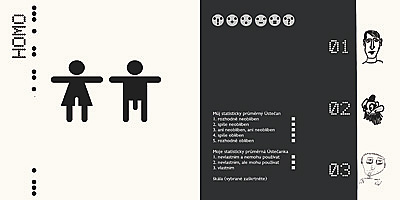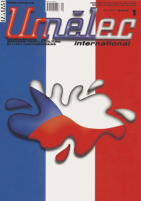| Zeitschrift Umělec 2002/1 >> Rizoto | Übersicht aller Ausgaben | ||||||||||||
|
|||||||||||||
RizotoZeitschrift Umělec 2002/101.01.2002 vorgestellt | en cs |
|||||||||||||
|
Founded in 1998, the art group Rizoto are Tomáš Trnobranský, Lucie Markvartová, and Martin Raudenský. Trnobranský and Markvartová graduated from the Graphic Design Studio of Professor Karek Míšek at the Decorative Arts and Design Faculty of Jan Evangelista Purkyně University in Ústí nad Labem, CZ, where Martin Raudenský currently teaches.
Treading the line between art and design, Rizoto’s work crosses over genres as diverse as comic art and computer animation. While still in school, Rizoto members put out the magazine Rizoto, which won them the Miroslav Prošek Award in 2000. In total they have published six monographic issues known for mocking popular health magazines in one moment and then offering instructions for terrorists on how to make explosives in the next. Individual issues combined sharp graphic symbols with clumsy child-like scribbles and drawings. In both their work and magazines, Rizoto claim to be searching for a “realistic” relationship to the city of Ústí nad Labem, the Czech Republic, where quality contemporary art is in a worse state than the city’s third-league hockey team. Using new Internet technologies, Rizoto have been busy producing animation and art work, the use of these means being simpler than print media and paper offering very little in the way of interactivity. But technology has not caused them to fall for popular slick and super-cool commercial graphic design. Rizoto have chosen instead to set into motion all those good old clumsy drawings. Nor do they fear presenting their creative projects in gallery spaces. However, their installations are often interpreted as subversion. For their first exhibition at the Emil Filla Gallery in Ústí nad Labem, Rizoto strung up translucent plastic sheets with graphic motifs and organized a house party. For Zvon 2002, the biennial of young artists in Prague, they stuck up orientation symbols around the gallery that were intended to confuse the unwary public (see pp. 32 –36). But whether they are showing in a gallery space, on the web or in a magazine, Rizoto always blend perfectly into the environment, adopting their means of expression to the location or medium. Their “realistic relationship” with themes and their own presentation represents an appealing new phenomenon on the young Czech art scene.
01.01.2002
Empfohlene Artikel
|
|||||||||||||













Kommentar
Der Artikel ist bisher nicht kommentiert wordenNeuen Kommentar einfügen